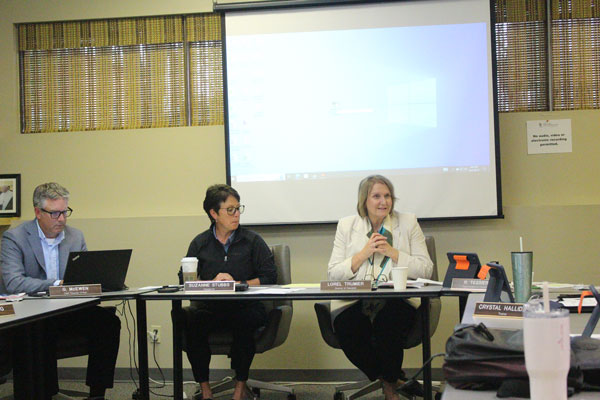
The Prince Albert Catholic School Division says a new resource system implemented at the beginning of the school year is having a positive impact on reading skills among pre-Kindergarten to Grade 3 students.
The division has implemented Heggerty resources, which are based on phonics and phonemic awareness, as part of their 2023 to 2026 Strategic Plan. At the board of education’s regular meeting on March 18, a delegation of superintendent Charity Dmytruk and St. Catherine Grade 2 teacher Krista Lambert showed trustees the impact the program is having. PA Catholic Education Director Lorel Trumier said it’s great to see.
“We really wanted to have our board exposed to the new resources that we had purchased and to see the work that our staff are doing in terms of professional development to support students reading and writing,” Trumier said.
Phonemic awareness is the ability to notice, think about and work with the individual sounds (phonemes) in spoken words. For example, this comes through learning how the mouth moves when pronouncing words.
Heggerty lessons are aligned with Saskatchewan curriculum and provide evidence-based explicit instruction on both phonetics and phonemic awareness. Pre-Kindergarten to Grade 3 teachers like Lambert have received two full days of training in Heggerty and reading instruction.
“We’re pleased that Krista was able to take time and come and share some of the nuances that she has within her classroom to talk about the explicit instruction procedures of Heggerty,” Trumier said. “We’re seeing some success, and we want to celebrate that and also acknowledge the work that our staff are doing in this effort.”
Heggerty is based in part around phonetics and visual aids Trumier explained that this is part of having a balanced literacy approach.
“It’s not just exposure to text and exposure to story. It also requires the ability for students to decode words and have some phonemic awareness to ensure that they can decode and support their skillset,” Trumier said.
Heggerty lessons provide a scope and sequence to instruction in phonemic awareness. They also align language instruction from Pre-Kindergarten to Grade 3 across all schools in the division.
“It’s a very tactile form of instruction where you can see (students) learning how to move their mouth when they’re saying it and that kinesthetic part of it makes it very engaging,” Trumier explained.
In Pre-Kindergarten, students receive 35 weeks of systematic play activities aimed at the three-year-old to four-year-old classroom. In Kindergarten, it is 35 weeks of phonemic awareness lessons. In Grade 1 it is explicit phonetic instruction combined with phonemic awareness. In Grade 2 it is 12 weeks of daily phonemic awareness. Finally, in Grade 3 it is intervention curriculum focused on developing phonemic awareness.
“We’ve prepared our classrooms from pre-Kindergarten to Grade 3 to have this programming involved,” Trumier explained. “It was a significant investment and we’re feeling that it was very successful and we’re looking forward to the future successes because these skills scaffold into learning. As they progress through those early years, they’ll have more exposure to that very intentional instruction on phonemic awareness.”
One benefit according to Dmytruk and Lambert was that the phonemic instruction was engaging and fun for students. This is done through use of visual aids and Lambert leaves a student who performs best on a day with a Hedgehog doll. The Hedgehog doll was presented to teachers at the end of one of their Professional Development days around Heggerty.
michael.oleksyn@paherald.sk.ca

